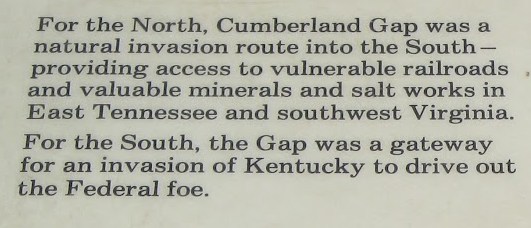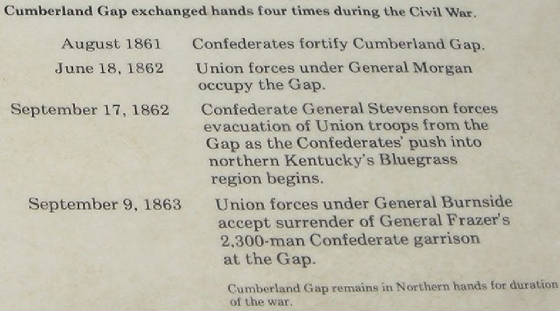|
Union Account of the Capture of the Cumberland Gap
General Grant was cognizant of the importance of the Cumberland
Gap during the Civil War, having resided in neighboring states for most of his life. The Army of the Cumberland was a Union
army named for the area. Grant traveled through the Cumberland Gap in
1864 and said, "With two brigades of the Army of the Cumberland I could hold that pass against the army which Napoleon
led to Moscow."
| Cumberland Gap Civil War Map |

|
| Cumberland Gap Civil War era map |
| Union take control of Cumberland Gap |

|
| The Union Army held the Cumberland Gap from Sept. 1863 onward |
Cumberland Gap, Tenn.
Sept. 8-10, 1863
Troops
of the Department of the Ohio.
The Confederate garrison
at Cumberland gap consisted of 2,500
men under the command of Brig.-Gen. John W. Frazer.
Maj.-Gen.
Ambrose E. Burnside, commanding the Department of
Ohio, determined upon the reduction of the place and sent
Brig.-Gen.
J. M. Shackelford with his cavalry brigade to
invest the south side of the gap. At the same time a new
division of
infantry, commanded by Col. J. F. De Courcy, was
ordered to occupy the north side of the mountain.
Shackelford
reached his position at 8 a. m. on the 8th and
immediately demanded the surrender of the garrison. This
demand was
refused and a few hours later De Courcy appeared on
the north side of the gap and made similar demand.
In the meantime
Burnside himself, with Gilbert's brigade,
Hascall's division, 23d corps, left Knoxville,
and after a
march of 60 miles in 52 hours joined the forces before the gap
on the morning of the 9th.
A third
demand for the surrender of the garrison was now made
and this time it was complied with, the entire Confederate
force
surrendering as prisoners of war.
At the same time there fell into Burnside's hands 36 pieces of
artillery, about
3,000 stands of small arms, large quantities
of ammunition, commissary and quartermaster stores, etc.
The occupation
of Cumberland gap placed the Union forces in
possession of all the important points in eastern Tennessee.
| Civil War occupation of Cumberland Gap |

|
| Union Army in the Cumberland Gap |
| Four times was a charm |

|
| It was back and forth between Union and Confederate control for the Cumberland Gap |
Source: The Union Army, Vol. 5, p. 333
(Related reading below.)
Recommended Reading: East Tennessee and the Civil War (Hardcover: 588 pages). Description: A solid social, political, and military history, this work gives light to the rise of the pro-Union and
pro-Confederacy factions. It explores the political developments and recounts in fine detail the military maneuvering and
conflicts that occurred. Beginning with a history of the state's first settlers, the author lays a strong foundation for understanding
the values and beliefs of East Tennesseans. He examines the rise of abolition and secession, and then
advances into the Civil War. Continued below...
Early in the
conflict, Union sympathizers burned a number of railroad bridges, resulting in occupation by Confederate troops and abuses
upon the Unionists and their families. The author also documents in detail the ‘siege and relief’ of Knoxville.
Although authored by a Unionist, the work is objective in nature and fair in its treatment of the South and the
Confederate cause, and, complete with a comprehensive index, this work should be in every Civil War library.
Recommended Viewing: The Civil War - A Film by Ken Burns. Review: The
Civil War - A Film by Ken Burns is the most successful public-television miniseries in American history. The 11-hour Civil War didn't just captivate a nation,
reteaching to us our history in narrative terms; it actually also invented a new film language taken from its creator. When
people describe documentaries using the "Ken Burns approach," its style is understood: voice-over narrators reading letters
and documents dramatically and stating the writer's name at their conclusion, fresh live footage of places juxtaposed with
still images (photographs, paintings, maps, prints), anecdotal interviews, and romantic musical scores taken from the era
he depicts. Continued below...
The Civil War uses all of these devices to evoke atmosphere and resurrect an event that many knew
only from stale history books. While Burns is a historian, a researcher, and a documentarian, he's above all a gifted storyteller,
and it's his narrative powers that give this chronicle its beauty, overwhelming emotion, and devastating horror. Using the
words of old letters, eloquently read by a variety of celebrities, the stories of historians like Shelby Foote and rare, stained
photos, Burns allows us not only to relearn and finally understand our history, but also to feel and experience it. "Hailed
as a film masterpiece and landmark in historical storytelling." "[S]hould be a requirement for every
student."
Recommended
Reading: Portals to Hell: Military
Prisons of the Civil War. Description:
The military prisons of the Civil War, which held more than four hundred thousand soldiers and caused the deaths of fifty-six
thousand men, have been nearly forgotten. Lonnie R. Speer has now brought to life the least-known men in the great
struggle between the Union and the Confederacy, using their own words and observations as
they endured a true “hell on earth.” Drawing on scores of previously unpublished firsthand accounts, Portals to
Hell presents the prisoners’ experiences in great detail and from an impartial perspective. The first comprehensive
study of all major prisons of both the North and the South, this chronicle analyzes the many complexities of the relationships
among prisoners, guards, commandants, and government leaders. It is available in paperback and hardcover.
Recommended Reading: The Life of Johnny Reb: The Common Soldier of the Confederacy (444
pages) (Louisiana State University Press) (Updated edition: November 2007) Description: The
Life of Johnny Reb does not merely describe the battles and skirmishes fought by the Confederate foot soldier. Rather,
it provides an intimate history of a soldier's daily life--the songs he sang, the foods he ate, the hopes and fears he experienced,
the reasons he fought. Wiley examined countless letters, diaries, newspaper accounts, and official records to construct this
frequently poignant, sometimes humorous account of the life of Johnny Reb. In a new foreword for this updated edition, Civil
War expert James I. Robertson, Jr., explores the exemplary career of Bell Irvin Wiley, who championed the common folk, whom
he saw as ensnared in the great conflict of the 1860s. Continued below...
About Johnny Reb:
"A Civil War classic."--Florida Historical Quarterly
"This book deserves to be on the shelf of every Civil War modeler and enthusiast."--Model
Retailer
"[Wiley] has painted with skill a picture of the life of the Confederate
private. . . . It is a picture that is not only by far the most complete we have ever had but perhaps the best of its kind
we ever shall have."--Saturday Review of Literature
Recommended
Reading: Touring the East Tennessee Backroads (Touring the Backroads) (380 pages) (John F Blair Pub;
2 edition) (October 1, 2007). Description: The historical facts in the first edition of Touring the East Tennessee
Backroads have not changed much since the book was first published in 1993, but highway construction and development has altered
the routes of the 13 tours. For this second edition, the author drove over 3,000 miles to update the tours where people such
as Daniel Boone, Davy Crockett, Sam Houston, Andrew Jackson, Sequoyah, Nancy Ward, and Clarence Darrow once traveled the same
backroads.
For related studies, try the Search Engine with the following: The Cumberland Gap Civil War
History, List of Battles, Union Account of the Capture of the Cumberland Gap, Tennessee, Kentucky, Union Confederate Army,
Captured Soldiers Regiments Troops Prisoners.
|

